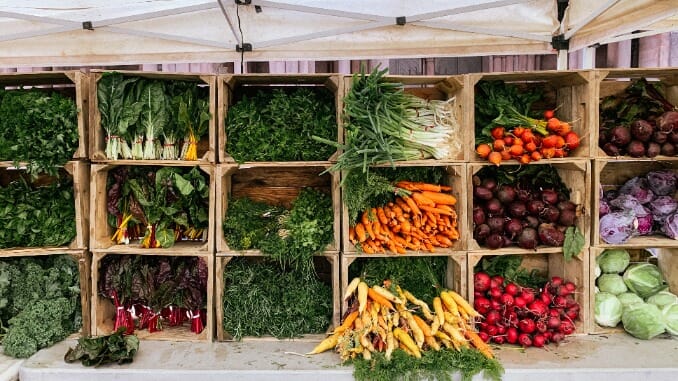
If you are what you eat, does it matter where your food comes from? The local food movement encourages people to eat locally grown or produced food. Locavorism has been on the rise for many years and still seems to be growing in popularity.
While eating local food provides some benefits, it does have a few pitfalls. Deciding whether to practice locavorism or not comes with a multitude of different factors to consider. Learning about the pros and cons of eating local can help you make better decisions about where you’re sourcing your food.
What counts as locally produced food?
Locavores are people who primarily eat locally grown, produced or processed food. However, just like the word “local,” locavorism means different things to different people. The most common definition of locally produced food is food produced and sold within 400 miles of the point of sale. Specific definitions aside, the key ideas of eating locally are to reduce the number of miles your food needs to travel to your table and to support the local economy.
What are the benefits of eating locally?
Fresh produce travels an estimated 1,500 miles before it’s consumed. When produce has to travel that far, it’s often picked before it’s ripe, lowering its quality. Additionally, all that travel emits more greenhouse gasses than locally produced food does. Both of these factors are big contributors to the growth of the local food movement, although promoting organic production, food security and contributing to the local economy are also major factors.
Unfortunately, eating local food may or may not have a significant impact since multiple factors are at play. As of 2008, transportation only accounted for around 11% of emissions in the life-cycle of food production. The remainder of those emissions come from the production phase. However, local producers can also reduce those emissions by practicing good stewardship like regenerative and organic agriculture.
Eating local supports small businesses and strong communities
Farmers are an integral part of the community, so supporting them is a good way to build the local economy. Buying from small farms also gives consumers the ability to get to know their local farmers and influence how their food is produced. For example, if there is enough interest in organic products, farmers will likely shift their practices to meet the demand.
Locavorism could reduce food and plastic waste
An estimated 30 to 40 percent of America’s food supply ends up wasted. Since locally produced food travels less, it tends to be fresher and taste better, which could lead to less waste.
At the supermarket, many foods are packaged in plastic. While farmers markets are far from perfect, they tend to produce less plastic waste, and producers are responsive to requests for less packaging. Consumers can reduce plastic waste even more by bringing their own reusable containers to their farmers markets.
Tips for eating local
Eating more local food begins with being more mindful about what you consume. Even if you don’t want to make the switch to buying primarily from local producers, it can be beneficial to look at your buying habits and ask questions. If you’re getting food from the supermarket, take a look at the labels; they usually contain information about where the food was grown, cooked or processed.
One of the most significant benefits of eating local food is getting to know the producers and getting involved in your community. Going to farmers markets is a good way to get connected with the people who grew your food.
The drawbacks of locavorism
Unfortunately, locavorism has its downsides. The main pitfalls of eating locally are seasonality, lack of oversight and cost.
Seasonality and regionality when eating local
Locally produced food changes from season to season, which means you won’t be able to get certain staples all year long, especially in extreme climates. But seasonality can also be positive since it forces consumers to get creative and eat a wider variety of ingredients. You can also potentially mitigate this problem by finding local greenhouses or hydroponic producers that grow your favorite seasonal produce year-round.
Local producers might have fewer regulations and less oversight
While each state has different rules about what small farmers can and can’t sell directly, there may not be as many regulations and requirements for locally grown food as there are for conventional produce.
While this lack of regulation might cause some concern, it can be a good thing for farmers since it makes it easier and cheaper for small farms to sell their products. If you’re curious about the safety of a given item, ask the producer about their growing or production techniques. While they likely won’t give you any trade secrets, they should happily tell you about the basic process or ingredients. If they don’t, it’s a red flag, and you should find a different producer.
The cost of eating local
Although locavorism is something some consumers aim for, it’s important to note that it’s a privilege to eat locally since not everyone can afford it. If you are on a budget but want to support local farmers, you can look for producers who are offering discounts for “misfit” produce or allow people to buy in bulk. Some areas also have community-supported agriculture programs or food co-ops. Consumers can potentially save money by getting to know producers and buying directly from them.
Is locavorism important or not?
Eating locally is not a silver bullet that will solve climate change—or our broken food system—by itself. Still, eating locally does have its benefits, even if it is a flawed model. If you want to support the local food movement and community growers, progress is key, not perfection. Buying locally when you can is a good idea, but it’s important to remember that there are barriers to eating this way for many people. It’s up to you to decide whether buying and eating locally is a priority for you and your family.